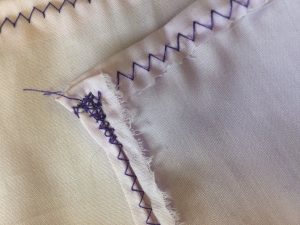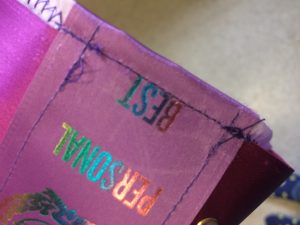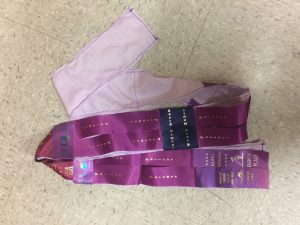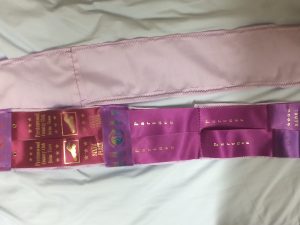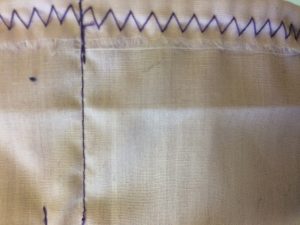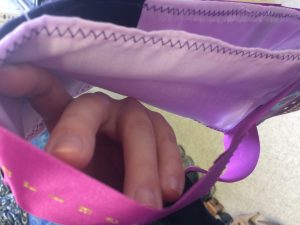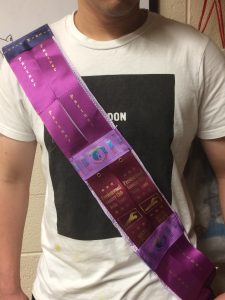In order to explore the phenomenon of the branding of the millennial generation as the “participation trophy generation,” our group constructed a pageant sash out of discarded participation ribbons, which we salvaged from the Durham Scrap Exchange. We reversed the concepts of worth traditionally associated with trophy-objects: whereas pageant sashes are typically reserved for first-place winners of contests, our sash is comprised of “trophies” that only commend participation in a contest—and not actual value, aptitude, or rank.
The ribbons themselves are made of cheap fabric, and have become discolored and worn with age; however, it is important to note that the texture of trophy ribbons seems to try to imitate silk or other high-end materials. Our sash therefore also plays with notions of worth and value on a materialistic level: our ratty and stained ribbons are sewn together in such a way to imitate more expensive fabrics, patterns, and colorations. That the sash is discolored is also significant when considering the cultural history of the color purple. Purple has been a symbolic marker of status and wealth, of prestige and power, for millenia––perhaps most notably in a biblical context, wherein the resurrected Jesus is often depicted draped in purple robes. In this light, our use of purple is ironic and playfully subversive, and the sash’s discolored purple comes to represent last-place status instead of superiority.
The sash was constructed by both hand- and machine-sewing the ribbons onto a thin piece of purple fabric. The fabric was originally a square, and had to be cut into four pieces and sewn together. The edges of the fabric were also sewn down to prevent the edges from fraying. Due to the fact that the base of the sash had to be pieced together, the thickness of the fabric was not consistent, which inevitably presented some challenges when sewing the ribbons onto the fabric.
Before we attached the ribbons to the sash, we spent time deciding on a pattern. We were limited in the number and color of fabrics that we had; some ribbons were vibrant purple, while others were dark plum or light pink. Our main goal was to achieve a sense of symmetry and pattern. We decided that the best way to achieve this was to lay down the ribbons on the table before we attached them to the sash. We started by picking the ribbons we would place at the shoulder and then laid the pattern out from there. We considered trying to make a cross-hatching pattern, but discovered this was difficult to sew, and that we would not have enough ribbons to cover the entire sash. So, we decided that grouping them according to color and length would allow us to achieve a compelling pattern. Laying ribbons horizontally and vertically also added variation to our pattern. Once we decided on a pattern, we sewed the ribbons on with the machine by making horizontal stitches first, attaching them all to the sash, and going back and making vertical stitches along the edges of the sash to secure them.
These issues that arose from the inconsistent thicknesses of the fabric were emphasized once we began sewing the ribbon onto the fabric, as the material the fabric was made of was both thicker and stiffer than the cotton it was attached to, which, at times made it difficult for the needle of the sewing machine to penetrate. There were several instances in which the thread became tangled and knotted, and the fabric could not be moved through the sewing machine. In fact, in an attempt expedite the process of constructing the sash, members of our group attempted to hand-sew the ribbons onto the fabric, which ended up being unsuccessful, and had to be taken apart in some places. However, these obstacles were somewhat anticipated, and were dealt with accordingly. What we were not expecting to be a challenge was the smooth finish of the ribbons, which made it difficult to grip and control the fabric both with our hands and with the foot of the sewing machine. Moreover, the speed of the machine was difficult to control and oftentimes would proceed much faster than we expected, resulting in skewed and angled lines—the force of the foot of the sewing machine descending so quickly resulted in the fabric moving a little. Better control of the sewing machine would come with experience. All in all, using the sewing machine resulted in neater lines, but limited us to being able to sew in only straight lines.
While the stiffness and smoothness of the ribbons made it difficult to work with, that aspect of the cloth contributed more toward the aesthetic and functional goals of the sash, as it was heavier and would hang off of the body, rather than clinging to the fabric of a person’s clothing and almost crumpling up in the way that the naked cotton beneath the ribbons would. This created a neater look, as the line of the sash on a person’s body was both smooth and continuous, furthering the regal look we were attempting to create. To a slight degree, however, the weight of the ribbons backfired on us a little, as we did not sew the entirety of the purple fabric to the ribbons, and the two layers would separate in some areas. Positioned properly, the sash looked cohesive nonetheless.
After placing the ribbons together and taking them apart repeatedly, we realized that even a simple, rectangular sash was incredibly hard to successfully construct the sash the way we had envisioned it in our minds, despite the fact that we thought this would be a relatively straightforward object to create, compared to something like a shirt, or a pair of pants. Moreover, the mistakes we made did not disappear completely, and would exist as reminders of the process of our making: for example, upon removing stitches and redoing them, we could see small but noticeable holes from where the thread was removed. Toward the end of this project, we realized that creating something from cloth is as much trial and error as creating with any other material, despite the pliable nature of the material.
